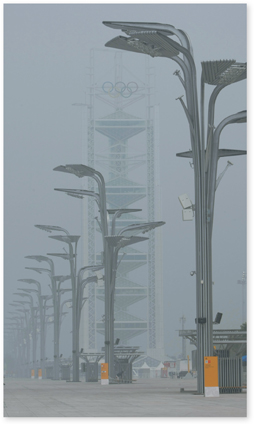Atmospheric Resources
 What are the major forms of air pollution?
What are the major forms of air pollution?
The atmosphere is a common resource whose quality has direct effects on health. After all, the atmosphere provides the oxygen we breathe! In addition, ozone, a form of oxygen that is found naturally in the upper atmosphere, absorbs harmful ultraviolet radiation from sunlight before it reaches Earth's surface. It is the ozone layer that protects our skin from damage that can cause cancer.
The atmosphere provides many other services. For example, the atmosphere's greenhouse gases, including carbon dioxide, methane, and water vapor, regulate global temperature. As you've learned, without the greenhouse effect, Earth's average temperature would be about 30° Celsius cooler than it is today.
The atmosphere is never “used up.” So, classifying it as a renewable or nonrenewable resource is not as important as understanding how human activities affect the quality of the atmosphere. For most of Earth's history, the quality of the atmosphere has been naturally maintained by biogeochemical cycles. However, if we disrupt those cycles, or if we overload the atmosphere with pollutants, the effects on its quality can last a very long time.
Air Pollution What happens when the quality of Earth's atmosphere is reduced? For one thing, respiratory illnesses such as asthma are made worse and skin diseases tend to increase. Globally, climate patterns may be affected. What causes poor air quality? Industrial processes and the burning of fossil fuels can release pollutants of several kinds.  Common forms of air pollution include smog, acid rain, greenhouse gases, and particulates.
Common forms of air pollution include smog, acid rain, greenhouse gases, and particulates.
▸ Smog If you live in a large city, you've probably seen smog, a gray-brown haze formed by chemical reactions among pollutants released into the air by industrial processes and automobile exhaust. Ozone is one product of these reactions. While ozone high up in the atmosphere helps protect life on Earth from ultraviolet radiation, at ground level, ozone and other pollutants threaten the health of people, especially those with respiratory conditions. Many athletes participating in the 2008 Summer Olympics in Beijing, China, expressed concern over how the intense smog, seen in Figure 6–10, would affect their performance and health.
 In Your Notebook Compare and contrast the atmosphere as a resource with fresh water as a resource.
In Your Notebook Compare and contrast the atmosphere as a resource with fresh water as a resource.

FIGURE 6–10 Smog Despite closing factories and restricting vehicle access to the city, Beijing remained under a blanket of dense smog just days before the 2008 Summer Olympics. Apply Concepts What component of smog is beneficial when part of the atmosphere, but harmful when at ground level?
Table of Contents
- Formulas and Equations
- Applying Formulas and Equations
- Mean, Median, and Mode
- Estimation
- Using Measurements in Calculations
- Effects of Measurement Errors
- Accuracy
- Precision
- Comparing Accuracy and Precision
- Significant Figures
- Calculating With Significant Figures
- Scientific Notation
- Calculating With Scientific Notation
- Dimensional Analysis
- Applying Dimensional Analysis




